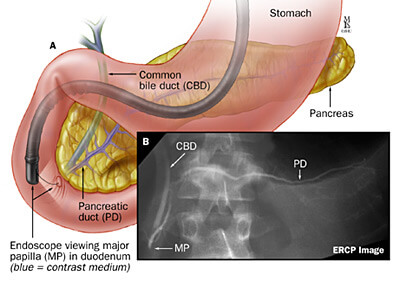ERCP (Endoscopic Retrograde Cholangio-Pancreatography)
This procedure is usually performed under intravenous sedation without general anesthesia. This procedure involves the use of a duodenoscope, which can be described as a thin, long, flexible tube with a camera at one end. It also has a fiber optic bundle that transmits lights to the camera and a chip to transmit video images to a TV screen.
This is inserted through the patient’s mouth and sent down the throat through the food pipe to the stomach and duodenum while the patient is lying on his or her back. The air pipe is left undisturbed so as to not interfere with the patient’s breathing. Since the patient is not under general anesthesia, he or she can move and turn according to the doctor’s needs. The papilla of Vater is a small nipple like structure with an opening to the bile duct and pancreatic duct. Once this has been identified, a small plastic catheter is passed through the duodenoscope into the bile duct or pancreatic duct through the papilla. Dye is then injected into the area and X-rays are taken of the bile ducts and pancreatic duct. In cases where a biopsy is needed, other instruments can also be passed through the endoscope. Plastic or metal stents can also be passed through this to relieve obstructions in the bile ducts and pancreatic ducts.

Benefits
- ERCP is the last invasive and most specific way of evaluating the bile ducts and pancreatic ducts. It can be performed safely and with minimal discomfort. In addition to providing a diagnosis, in many cases it allows the physician to perform specific treatment.
- Frequently a sphincterotomy (papillotomy) is performed. This procedure uses a thin wire with electrical cautery to enlarge the opening of the bile duct. Stones can be removed or a drainage tube (stent) can be placed to relieve an obstruction.
What are the reasons for ERCP?
The liver, bile ducts, gallbladder, pancreas and the papilla of Vater can be involved in numerous diseases, causing myriad of symptoms. ERCP is used in diagnosing and treating the following conditions:
- Blockage of the bile duct by gallstones, cancer, strictures (scarring) or compression from adjacent organs or tumors
- Jaundice (yellow coloring of the skin) due to obstruction of the bile duct, also causing darkening of the urine and light colored stool.
- Confirming the diagnosis of cancer of the pancreas or the bile duct, so that surgery or other treatment can be tailored to the disease
- When there is suspicion that the Sphincter of Oddi within the Papilla of Vater, that controls the flow of bile and pancreatic juice, is not working normally (Sphincter of Oddi dysfunction)

